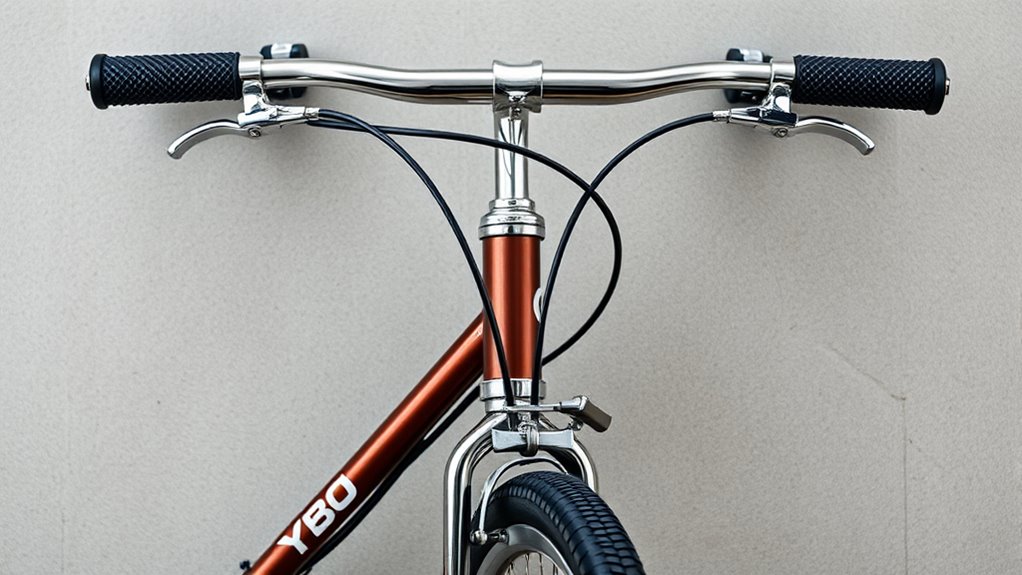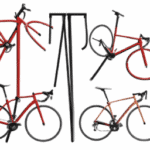Understanding bicycle anatomy helps you choose, maintain, and optimize your ride. You’ll want to know about the frame, which determines stability and comfort, and the gear mechanisms that let you adapt to different terrains with ease. The wheels, handlebars, saddle, and pedals all work together to provide control and efficiency. Properly preserving these components ensures a smoother, safer ride. To learn more about each part and how they connect, keep exploring what makes your bike perform at its best.
Key Takeaways
- Overview of basic bicycle components including frame, wheels, handlebars, and drivetrain.
- Explanation of frame geometry and how it affects riding style, comfort, and handling.
- Description of gear mechanisms, types, and maintenance to ensure smooth performance.
- Details on braking systems, tires, and suspension for safety and ride quality.
- Tips on customizing and adjusting bicycle parts for different terrains and rider preferences.

A bicycle is a simple yet intricate machine composed of various parts that work together to provide a smooth ride. One of the first aspects you’ll notice when examining a bike is its frame geometry. This refers to the angles and lengths of the tubes that make up the frame, influencing how the bike handles and fits your body. A bike with a more upright geometry offers comfort and stability, ideal for casual riding or commuting. Conversely, a bike with aggressive, race-oriented geometry tends to have a lower handlebar position, allowing for more aerodynamic positioning and enhanced speed. Understanding frame geometry helps you choose a bike that suits your riding style and body type, guaranteeing comfort and control, especially on longer rides or technical terrains.
Moving beyond the frame, the gear mechanisms play a vital role in your riding experience. These systems allow you to change gears, making pedaling easier or harder depending on the terrain. Modern bikes typically feature multiple gears, managed through shifters located on the handlebars. When you operate these shifters, they move derailleurs that guide the chain across different sprockets or chainrings. This setup lets you maintain an ideal pedaling cadence whether you’re climbing a hill or cruising on flat roads. The efficiency of gear mechanisms directly impacts your riding comfort and performance. Well-maintained gears enable smoother shifts, reducing strain on your legs and preventing chain slips that can be frustrating or dangerous. You’ll also find that some bikes have internal gear hubs, which offer gear changes enclosed within the hub itself, providing protection from dirt and weather, and requiring less maintenance. Additionally, proper zoning regulations are essential to ensure your bike setup complies with local laws, especially if you’re considering building or parking your bike in designated areas.
Understanding how frame geometry and gear mechanisms influence your ride can help you make informed decisions when choosing or adjusting your bike. For example, if you’re planning on tackling hilly terrains, a bike with a wide gear range and a geometry suited for stability will serve you better. If comfort is a priority, opting for a frame with relaxed geometry and easy-to-use gear systems ensures more enjoyable rides. Regular maintenance of these components is essential; keeping the gears clean and properly adjusted guarantees smooth shifting and prolongs the lifespan of your bike. By paying attention to these details, you’ll enhance your riding experience, making each journey more efficient and enjoyable. Ultimately, understanding how frame geometry and gear mechanisms work together empowers you to customize your bike to your specific needs, whether for commuting, fitness, or adventure.
Frequently Asked Questions
How Do I Choose the Right Bicycle Size for My Height?
To select the right bicycle size for your height, focus on the frame fit and saddle height. Measure your inseam and compare it to the bike’s standover height—ideally, you should have 1-2 inches of clearance. Adjust the saddle height so your leg slightly bends at the bottom of each pedal stroke. This ensures comfort and efficient pedaling, making your ride safer and more enjoyable.
What Maintenance Is Needed for Different Bicycle Components?
You should regularly check your bicycle components for maintenance. Follow lubrication schedules for moving parts like chains and derailleurs to prevent rust and guarantee smooth riding. Inspect brake pads frequently and replace them when they’re worn down to maintain stopping power. Additionally, tighten bolts and check tire pressure weekly. Proper maintenance keeps your bike in top shape, extends its lifespan, and keeps you safe on every ride.
How Can I Improve My Bicycle’s Aerodynamics?
To improve your bicycle’s aerodynamics, start by wearing aerodynamic clothing to reduce drag. Adjust your handlebar positioning so you stay low and streamlined, decreasing wind resistance. Keep your body aligned with the bike’s frame and avoid unnecessary movements. Consider installing aero wheels or streamlined accessories. These tweaks help you cut through the air more efficiently, making you faster and more comfortable on your rides.
What Are the Signs of Worn-Out Bike Parts?
You’ll notice worn-out bike parts through signs like uneven tire inspection, which shows bald spots or cracks, and brake pad wear, evident if they’re thin or grooved. Listen for squeaking when braking, and feel if the brake response is delayed. Check your chain and gears for rust or stiffness. If you observe these signs, it’s time to replace or service your parts to keep your bike safe and efficient.
How Do I Customize My Bicycle for Different Terrains?
Did you know that cyclists who customize their bikes for different terrains ride 30% more efficiently? To do this, start by adjusting your tire pressure to suit the terrain—lower for dirt and gravel, higher for pavement. Also, tweak your saddle height for comfort and power. These small changes make a big difference, ensuring you stay comfortable and perform your best no matter where you ride.
Conclusion
Now that you know your bicycle inside and out, it’s like holding the keys to a trusty steed, ready to take you anywhere. Understanding each part helps you ride safer and enjoy every mile more. Think of your bike as a finely-tuned orchestra, where every component plays its part. With this knowledge, you’ll feel more confident and connected on every ride—your journey’s just beginning, and the road awaits with open arms.
















